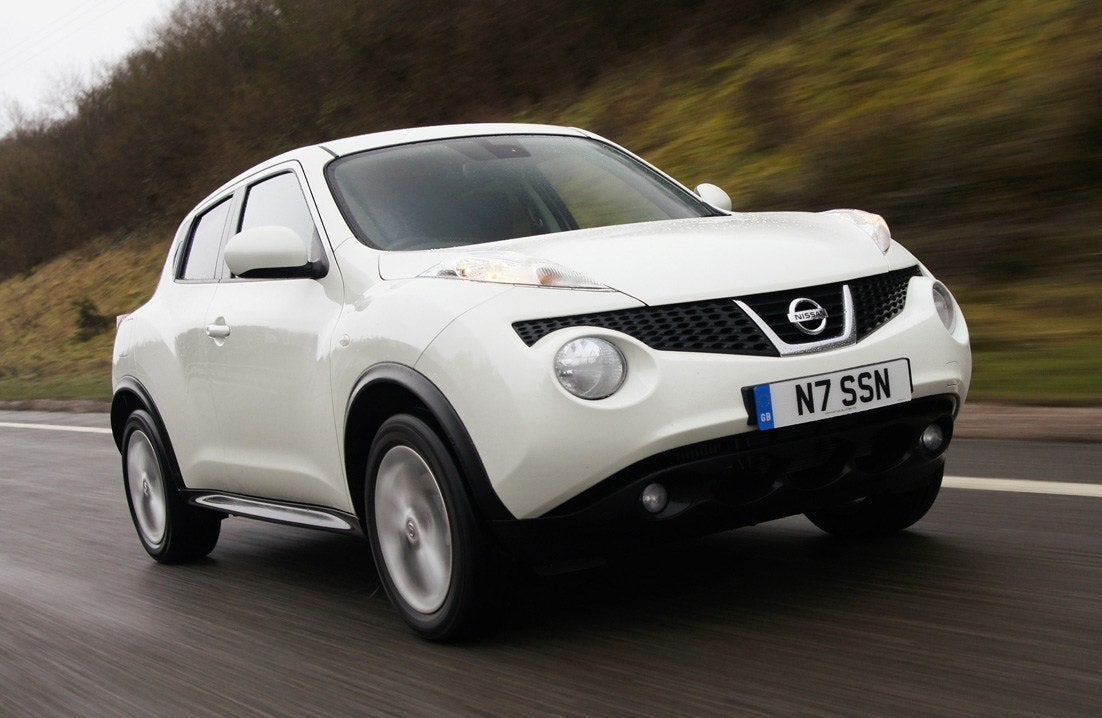Nissan Juke (2010-2019) Review
Quick overview
Pros
- Distinctive looks
- Value for money
- Nissan robustness
Cons
- Woeful boot space on early cars
- Weak 1.6-litre engines
- A bit too sporty and impractical for some
Overall verdict on the Nissan Juke
"In this Nissan Juke review we are looking at a small crossover that defined the sector, and was the car against which all the other crossovers were judged. By bringing a distinctive design and SUV characteristics to the small car sector it stole a march on conventional rivals and had those competitors scrambling to create their own version. It's far from a perfect car but has understandable appeal, and with so many used examples to choose from it makes an attractive secondhand buy."

With the Juke, Nissan did it again. The firm’s British design studio had already created a sector-defining trend-setter with the Qashqai, the world’s first family-sized crossover SUV. The Juke saw it repeat the formula in the small SUV market. Once again, everyone had to follow Nissan’s lead, and the Juke enjoyed considerable success over the years.
Truly, there was nothing quite like it at launch. And we don’t simply mean because its chunky, high-rise stance was unlike any other hatchback. No, Nissan’s designers also turned the dial up to 11 on the boldness, with the car wearing a genuinely unique and stand-apart look. Love it or loathe it, you can’t deny the Juke still has impact, even today.
Nissan launched the car with a small, select range of engines: 1.6-litre petrol, 1.6 turbo petrol and 1.5 diesel. The early engines were a bit on the humdrum side, if we’re being frank, and many buyers actually erred towards the diesel. This had a bit more go than the aged 1.6 petrol, and delivered more miles per gallon.
It seemed to suit the Juke’s sporty set-up as well, surprisingly. To match its styling, Nissan gave the Juke reasonably firm suspension, which made it feel chuckable and kept body-roll in check around bends. This did have an impact on ride quality, though, with a stiff and choppy feel at times. Later models were better in this respect, although still not brilliant.
The Juke also felt sporty from behind the wheel. It had high-mounted seats and a commanding driving position, delivering the SUV-style confidence that buyers so love. It also had a similarly dramatic cabin design, with big round dials, a sporty steering wheel, bold centre console and a dramatic coloured panel in between the front seats that resembled a motorcycle fuel tank. It had genuine showroom appeal.
Practicality was lower down the agenda, though. The aggressive lines mean that, although actual space isn’t too bad by small hatch standards, it’s very dark in the back, and smaller children won’t have a great view out. The boot was also very poorly packaged, with insufficient space and practicality for family use.
Nissan recognised this and, when the Juke was revised in 2014, significant work was put into making the boot roomier and more practical. A welcome new 1.2-litre turbo petrol engine was also introduced, making entry-level models much more competitive in terms of performance, economy and ease of use. You can spot these cars from their tidier front end design, which includes smart LED running lights.
The first-generation Nissan Juke had an unusually long life by modern car standards. It was on sale for nine years, before finally being replaced by the bigger, more grown up second-generation Juke. This means that towards the end of its life, extremely good-value versions were added to the range, to keep the appeal high.
On the second-hand market, the Juke is rousing the same sort of excitement it once did amongst new car buyers. For the money, it is a striking used car alternative to the more humdrum norm. The number sold when new means there’s a huge amount of choice out there, too. Read on for all you need to know about buying a used Nissan Juke.
If you're looking for the newer version, you need our Nissan Juke review.
Is a used Nissan Juke right for you?
If you’re bored of the usual five-door hatchbacks, you’ll love the Nissan Juke. There’s nothing else quite like it, and it is definitely one of the most distinctive small cars for the money. That it’s as interesting inside as on the outside adds to the appeal. It definitely will be a talking point for everyone you take out in it.
Early petrol engines aren’t the most economical or efficient performers. We think the later 1.2-litre turbo is a better bet for lower-mileage drivers, and the diesel is worth checking out if you cover a high annual average. The suspension set-up is also on the sporty side, so don’t expect something that gives the optimum smooth-riding comfort and compliance.
What really lets the Juke down, particularly in pre-facelift guise, is interior practicality. It is dark in the rear seats and the boot is very impractical and compact. Later cars were markedly improved, but they were still bettered by more conventional alternatives. Given the Juke’s high-rise appearance, this might restrict its appeal for some.
What’s the best used Nissan Juke model/engine to choose?
The 1.6-litre petrol will be the cheapest Juke engine on the market, but it’s not the best. It feels flat and could be more fuel-efficient, too. If you can find a 1.5 dCi diesel for similar money, you might be better off choosing that – although the average mileage of a used example might be higher.
You’re best going for the 1.2T engine, which arrived in 2014. It is better on fuel and much more responsive, thanks to the boost from the little turbocharger.
Basic Visia trim is just that, a bit too basic. We like Acenta, which offers good value, and N-tec, which combines this with good looks. The most well-equipped Jukes are Tekna versions, with some neat onboard gadgets that will be a further talking point.
What other cars are similar to the Nissan Juke?
Early on in the Juke’s life, there was nothing quite like it. It took a while for similar cars to arrive – vehicles such as the closely-related Renault Captur, plus the Ford Ecosport, Peugeot 2008 and Honda HR-V. Vauxhall actually sold two alternatives: the more rugged Mokka (later renamed Mokka X) and more practical Crossland X.
Later arrivals include the Citroen C3 Aircross, Kia Stonic and Mazda CX-3, with more competitors arriving all the time.
Comfort and design: Nissan Juke interior
"Design is the name of the game with the Nissan Juke. That radical exterior, with its smiling grille, big round driving lamps and ‘bug eye’ headlights, still stands out. And while the interior is inevitably a bit more dated, it’s still an interesting place to be."
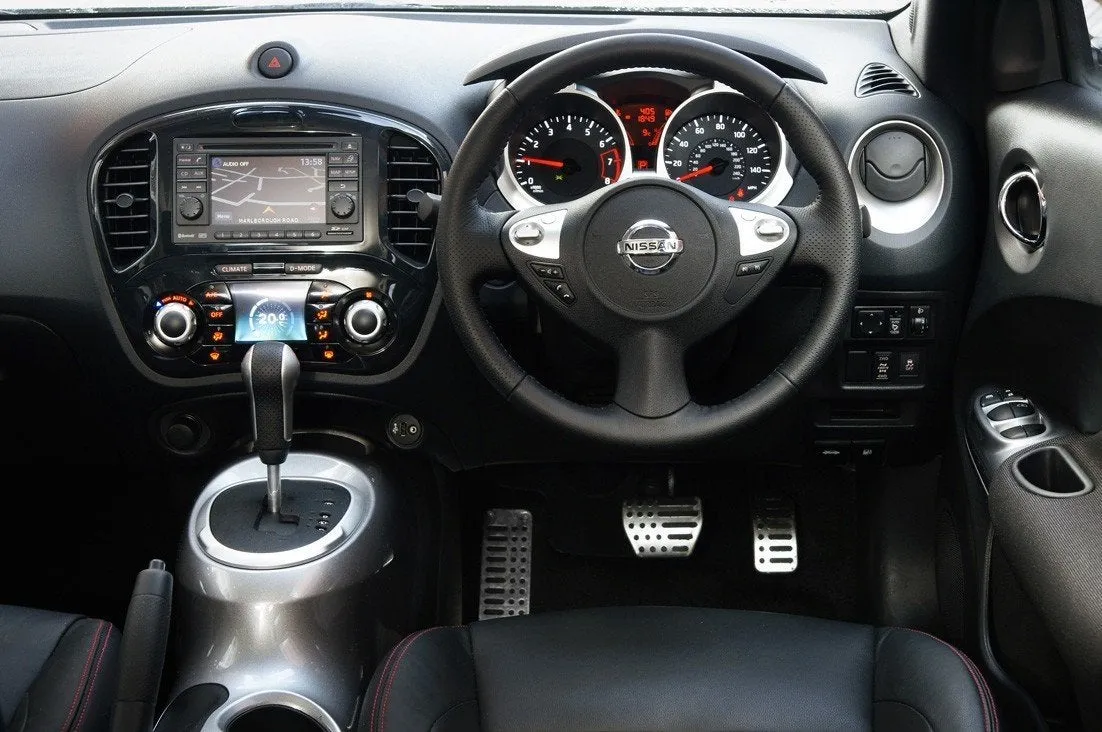
It’s a bold and upright dashboard layout, in complete contrast to the more open-plan feel you normally get in a small car. The shape itself gives it presence behind the wheel, and that’s before you clock the many neat details Nissan has built in.
You don’t get a plain old set of instruments, for example, you get two big dials, set within deep cowls, with a stylish freestanding visor to shield them from the sun. Located in the middle is a digital display that includes trip computer information, plus the engine temperature and fuel gauges.
The centre console is high and freestanding. The radio is built into the top – with some models getting an infotainment screen – with heater controls below. Some models boosted this with a digital display that must have looked super-futuristic in 2010, but now looks… well, very 2010.
The motorcycle fuel tank-style centrepiece looks stylish and distinctive. New Juke buyers could choose it in different colours and, if you keep it nicely polished and free from greasy hand smudges, it still looks cool. Other smart features include a sporty steering wheel similar to that from the 370Z sports car, metal-look door handles and distinctive round air vents.
Quality and finish
The Juke is a well-built car with tight fit and finish. The materials aren't the highest quality, however. Quite a few of the plastics on the dashboard are on the hard and scratchy side, and look just a bit too cheap and shiny. Some lower-range versions have particularly dated-looking features, such as the cheap heater controls and aged stereo unit.
Nissan did put more effort into what makes the Juke feel so distinctive, though. The painted plastic central structure is a good piece of design with a rich finish. The instruments have a quality appearance – they too could have come straight from the 370Z – and minor switchgear such as the electric window switches and column stalks has a well-engineered feel of Japanese integrity.
It’s worth adding that Nissan’s good build quality means even early and higher-mileage models should still feel tight and look respectable inside. The plastics might not be of the highest standard, but they’re hard-wearing, and the firm seats feel robust and well-padded.
Infotainment: Touchscreen, USB, nav and stereo in the Nissan Juke
You don’t get any form of infotainment in the cheapest Juke – just a dated looking stereo head unit that seems glaringly out of date. You need to add on the optional sat-nav to get any sort of touchscreen functionality. Saying that, this wasn’t unusual for cars of this time, although it’s still worth looking out for models fitted with navigation because of the extra functionality they offer.
An interesting gadget is fitted to Acenta and Tekna models. Instead of the basic ventilation dials, they get a custom colour display that switches between climate control and the ‘Nissan Dynamic Control System’. This lets drivers choose between Normal, Sport and Eco driving modes, altering the weight of the steering and response of the accelerator pedal.
A curiously cool extra is the power and torque display that can be shown within it – completely pointless but somehow in keeping with the Juke’s sporty feel.
Space and practicality: Nissan Juke boot space
Those in the front have a nice, high-up driving position that feels confident and commanding. The Nissan feels that bit safer as a result, and the extra visibility is useful in town. A clever design touch are the raised dimples on the top of the headlights, which make it easier to park. Less clever is the lack of reach adjustment for the steering wheel, although it does go up and down.
In the rear, the Juke is a mixed bag. Legroom isn’t so bad, and the high mounted front seats mean it’s actually pretty good for foot space beneath the chairs. The rear bench is a little higher than the small hatchback norm, helping comfort. It slides back and forth so the owner can juggle boot space and rear passenger room.
Headroom is compromised, though, as the roofline dives down towards the rear. The back windows are also small, and the shoulder line is a little on the high side. With bulky front seats as well, it all feels rather claustrophobic.
Some will also find the rear door handles annoying – they are of the ‘hidden’ type, with nail-breaking handles mounted high up on the door frame: not very easy to use at all.
Boot space in the early Juke was, genuinely, terrible – just 240 litres, which is smaller than almost anything else on the market. It’s more city car-sized than what you’d expect in a small SUV, and easily beaten by conventional cars such as the Ford Fiestas.
The space itself was also not very practical, with the boot much too shallow and awkwardly shaped. There was extra room beneath the boot floor – but only 11 litres of it, so not very useful at all.
Nissan realised its mistake and heavily re-engineered the Juke to create more boot space for the 2014 facelift. It now extended to 377 litres, and grew further if the sliding rear seat was located in its forward position. That’s still not really class-competitive, but a great deal better than before. Early Jukes had a completely flat load space with the rear seats folded. For later models, there was a step in the floor but, given the extra space on offer, few will mind.
There are ISOFIX mountings for child car seats on the outer two rear seats, but you don’t get one on the front passenger chair. There isn’t an airbag cut-off switch, either.
The Nissan Juke's dimensions are 4135mm long, 1765mm wide and 1565mm tall.
Handling and ride quality: What is the Nissan Juke like to drive?
"Nissan engineers were clearly quite excited by the Juke, because they gave it an energetic, sporty set-up that delivered a lively feel behind the wheel. There’s certainly little body-roll, which will be welcomed by some who might be deterred by its high-riding SUV stance. This means it’s fairly neat and tidy through corners, and won’t start leaning over or feeling lacking in control."
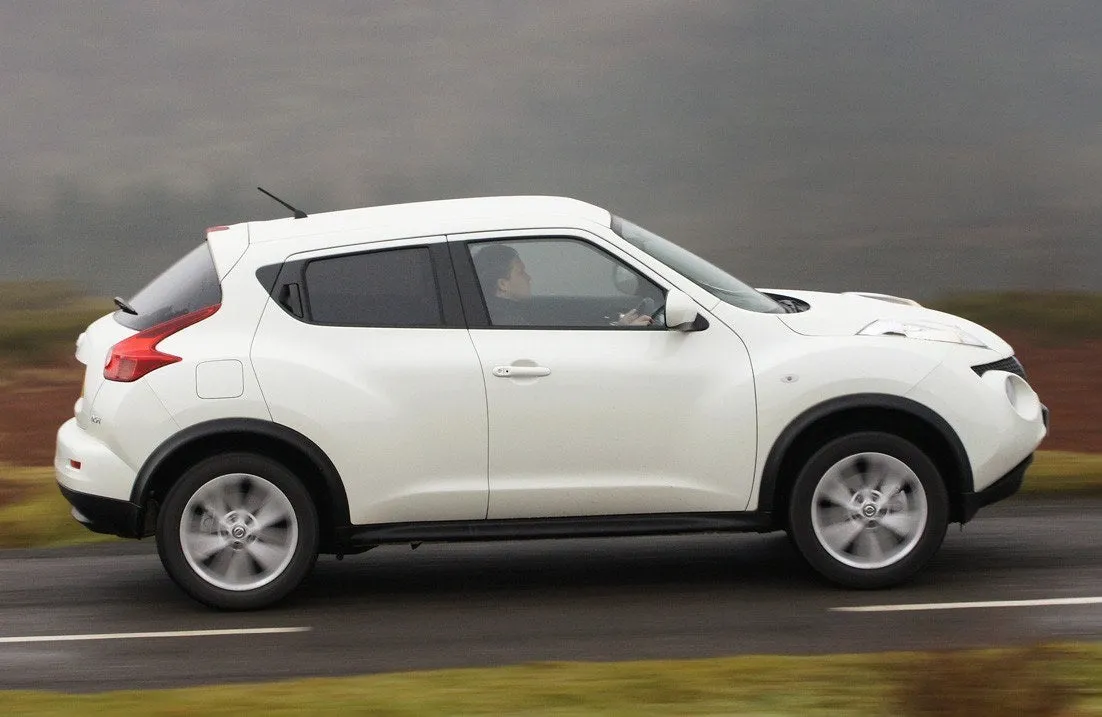
It’s a shame there isn’t more steering feel to back up this agile nature. Something like a MINI hatchback has far more feedback through the wheel, which gives drivers more confidence. Even switching from Normal to Sport mode via the Nissan Dynamic Control System doesn’t particularly add any more dynamism. Sportier Nismo models weren’t quite the hot hatch real deal, either.
The smallest wheels you will find on most Nissan Jukes will be 17 inches. This is on the large side for a small car, and it does mean the ride is a little firmer than a conventional small hatch. However, the Juke does have more suspension travel, and the engineers have set it up to make good use of this. Basic models therefore soak up bumps with reasonable assurance, even if they are a bit more nimble than a regular car.
What lets down ride quality is the amount of noise transmitted by the suspension. This makes the ride feel worse than it actually is – and it’s worse still on versions with larger alloy wheels, which add an extra degree of crash and bang to proceedings.
What engines and gearboxes are available in the Nissan Juke?
The choice of engines is small and, prior to 2014, rather disappointing. The 1.6-litre petrol engine was the mainstay of the range, producing 117PS or, in entry-level guise, 94PS. It’s a mediocre engine and needs noisily revving to give its best. There was also a 190PS direct injection turbo petrol, which has better performance, but also isn’t the nicest engine to drive.
We think early Juke buyers are better off with the Renault-derived 1.5-litre dCi turbodiesel, which produced 110PS. It is more relaxed, thanks to its turbo pull, and gives much better economy in the real world.
You will also find Jukes with an automatic gearbox on sale second-hand. This is a CVT-style transmission, with the trademark ‘slipping clutch’ feel, which is unusual. It is efficient, but we prefer the more straightforward and conventional feel of the manual gearbox – even if the high-mounted lever, set within that cool central ‘fuel tank’, promises more engagement and interaction than it actually delivers.
The best Juke engine is the post-facelift 1.2-litre turbo. This produced 115PS and, most importantly, offers significantly improved pulling power when compared to the 1.6 petrol. Called DIG-T 115, it also had fuel-saving engine stop-start, plus a good deal more refinement than the noisy 1.6 unit.
There was a performance Nissan Juke Nismo, too. This has a 200PS 1.6-litre turbo petrol engine and all-wheel drive, which uses torque vectoring like a Nissan GT-R supercar. The regular DIG-T 190 was also available in all-wheel-drive guise, for extra winter-weather traction and reassurance.
Refinement and noise
The Nissan Juke isn’t the most refined small car you can buy. As we’ve mentioned, there’s a little bit too much road noise, and the suspension can be on the clattery side when tackling rough roads. If you pick larger 18-inch alloy wheels, it’s rowdier still.
There’s rather a lot of wind noise at speed as well, perhaps impacted by the car’s blunt, upright front end. It seems a bit too whistley from around the door mirrors and you’ll be cranking up the stereo at speed to offset it.
Then there’s engine noise. The 1.2 DIG-T isn’t so bad here, but the 1.6 petrol is rowdier, both because you have to rev it and because it makes rather a gruff noise. The 1.5 dCi diesel has the familiar diesel clatter, but also enough turbo pull in reserve not to need revving hard to make progress – and it settles into the background at speed.
Safety equipment: How safe is the Nissan Juke?
Euro NCAP rated the Nissan Juke a five-star car when it was crash-tested back in 2011. It scored a decent 87% for adult occupant protection. Child occupant protection was pretty good too, on 81%. Safety assist features were rated 71%, but pedestrian protection was much less impressive – at just 41%. Again, perhaps the Juke’s bulky upright front end is to blame.
Front and side chest airbags are standard, and the Juke has curtain airbags that extend from front to rear. There isn’t a knee airbag for the driver or passenger, though, and it’s only they who get any form of seatbelt pretensioner or load limiter, with rear-seat passengers being left out.
ISOFIX is fitted to the rear seats, but not the front, and there isn’t an airbag cut-off switch. The only standard active safety feature was stability control when the Juke was tested in 2011. Owners couldn’t even option a speed limiter device. This was improved when the Safety Sense pack became available (much) later. However, as it was late into the car’s life, Euro NCAP didn’t bother retesting it.
MPG and fuel costs: What does a Nissan Juke cost to run?
"The 1.6-litre petrol engine is quite a thirsty thing. In official tests, it manages no higher than 49mpg, with some models dropping down to 39mpg. Experience tells us it’s not the best in real-world use either, because you have to rev it to offset its lack of pull."
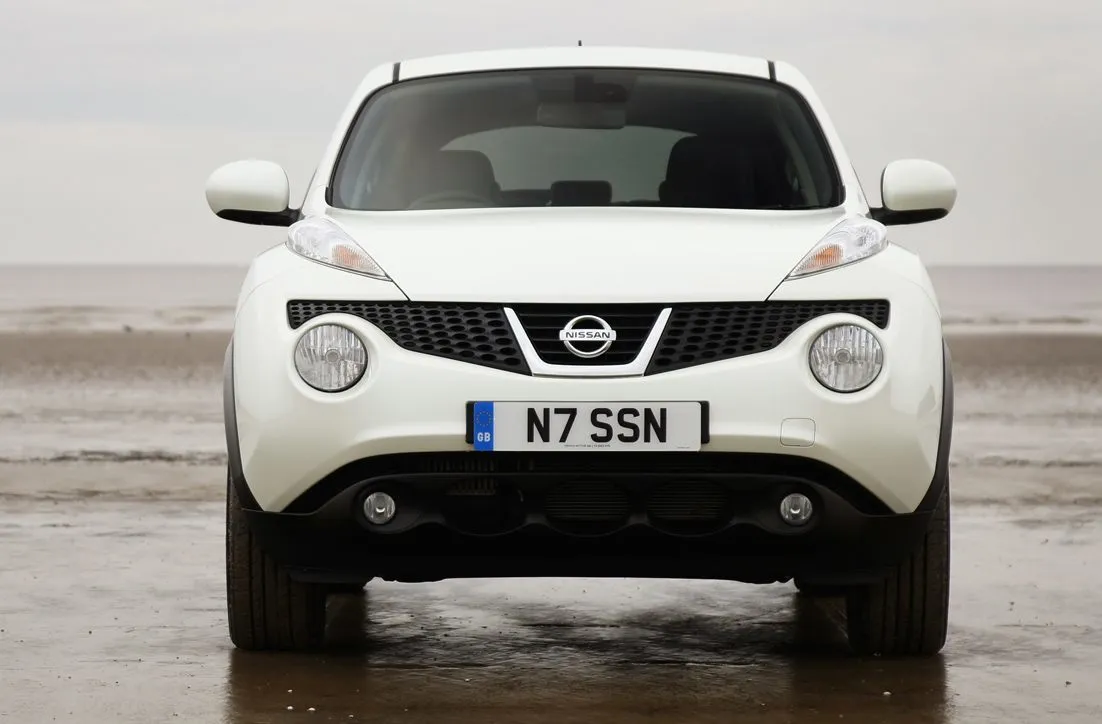
Likely to deliver better economy is the 1.2-litre turbo. On paper, this returns as much as 51mpg, and we think it will be reasonably economical in day-to-day use as well.
Best for keeping fuel costs low are the diesels – particularly the 1.5-litre dCi. This Renault engine can average as much as 71mpg, which should mean fuel costs that are considerably lower than for the petrol – even if you don't drive hundreds of miles a week.
How reliable is a Nissan Juke?
The Nissan Juke scored an unremarkable 9.00 out of 10 for reliability in the HonestJohn.co.uk Satisfaction Survey, which is a middling score compared to other Nissans and rivals in the class.
As a brand Nissan didn't do terribly well either, finishing 19th out of 30 manufacturers.
Insurance groups and costs
If you’re coming from a small hatchback, you might find Nissan Juke insurance groups and costs a little bit more expensive than expected. Even the base 1.6 Visia has a group eight rating, with the more powerful model scoring group 12 and the diesel in group 13. A 1.2 DiG-T Acenta is group 11 and a 1.6 DIG-T Acenta is a steep group 21.
This is the price you pay for the Juke’s desirability and more appealing SUV stance. We’d say it’s probably worth getting a quote before you start looking at used Juke. That way, you can weigh up how much you’re prepared to spend on insurance.
VED car tax: What is the annual road tax on a Nissan Juke?
The thirsty 1.6-litre petrol-engine Juke suffers from higher-than-average VED (road tax) as well. Even the cheapest version is £165 a year, while the performance Nismo version is £220 a year. The specialist Nismo RS costs as much as £265 a year.
Diesel models are better. The 1.5 dCi costs from £20 a year for VED, while the 1.2 DiG-T is £135 a year. It’s because the Juke is a higher-rise, less efficient small SUV that it costs more than a regular small hatchback.
How much should you be paying for a used Nissan Juke?
"Nissan Juke prices are growing ever-more appealing. Very early 1.6-litre cars can be found under £3,000, which is tempting for a car that still looks fresh and contemporary. We’d suggest looking for Acenta versions, though, as the base Visia is just a bit too spartan. You will also find 1.5 dCi versions at this level, although they may have done higher than average miles."
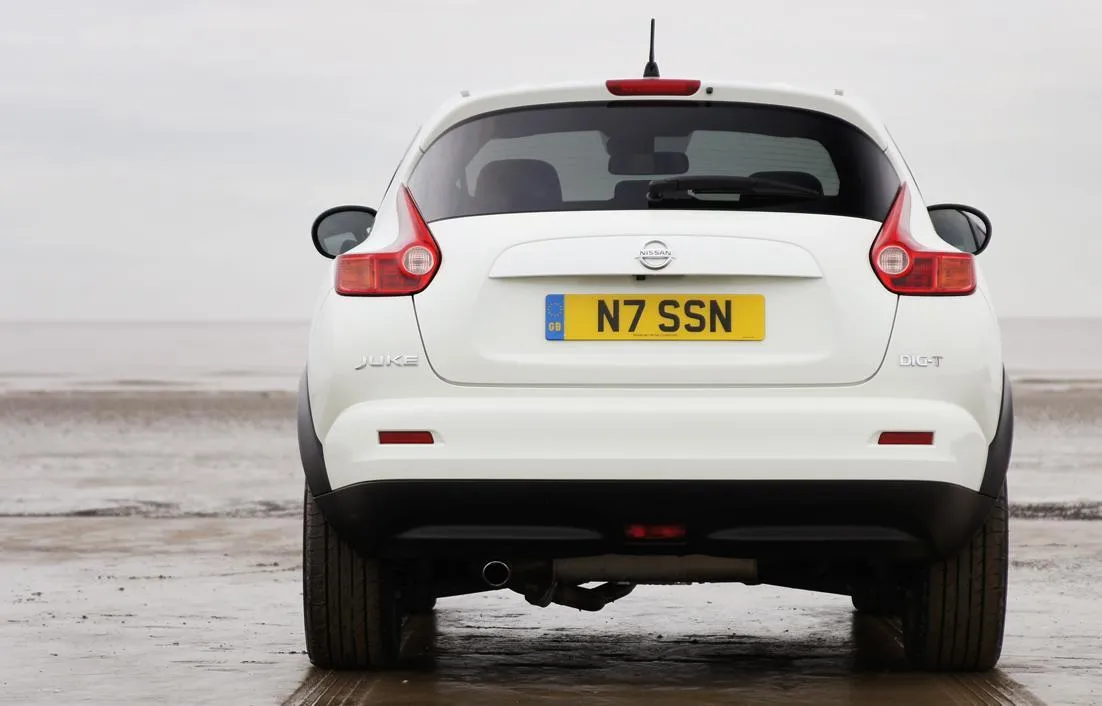
More practical facelifted cars cost from just under £6,000. If you can stretch to these, it’s well worth it, because of the extra practicality you get. The 1.2-litre DIG-T turbo models cost from just under £7,000 for 2015-on vehicles, and this represents a lot of car for the money.
Which would be more interesting, a base-spec new Dacia Sandero, or a five-year-old turbocharged Juke with plenty of life left in it, plus a fair bit less depreciation over the next couple of years?
Trim levels and standard equipment
The base-spec Nissan Juke Visia has air-con, alloy wheels, six airbags and ESC, but Acenta is more appealing. It has 17-inch alloys, climate control, Bluetooth, a USB socket and the neat Nissan Dynamic Control System. The Nissan Juke Tekna is the best equipped, with heated leather seats, Nissan Connect infotainment, a reversing camera and keyless entry with a stop-start button.
There were various special editions throughout the Juke’s lifetime. The 2012 Nissan Juke Shiro had a special finish, while 2017 Nissan Juke Tekna Pulse offered an upgraded stereo from French premium brand Focal. The Nissan Juke N-Connecta Style had a styling pack, xenon headlights and 18-inch alloys.
Another minor facelift came in 2018. This saw the introduction of a Nissan Juke Bose Personal Edition version, plus two colourful interior personalisation colour packs: Energy Orange and Powder Blue.
Ask the heycar experts: common questions
Is it worth buying a Nissan Juke?
What are the cons of the Nissan Juke?
Is Nissan discontinuing the Juke?
Get our latest advice, news and offers
Keep me updated by email with the latest advice, news and offers from heycar.
By submitting you agree to our privacy policy
